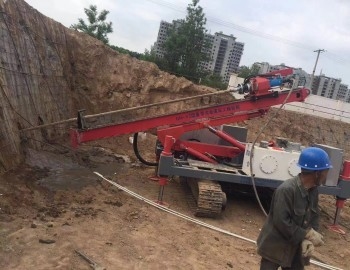
September 17, 2022

Anchoring Mechanism
The basic principle of slope anchorage is to rely on the shear strength of the stable strata around the anchor bolt to transfer the tensile force of the structure ( reinforced object ) to stabilize the structure or maintain the stability of the slope excavation surface itself.
Suspension Mechanism
The bolt support is to suspend the weak, loose and unstable rock and soil mass on the deep stable rock and soil mass through the bolt to prevent its separation and slippage.
![]()
Action Mechanism of Composite Beams
The thin rock mass is considered as a beam (simply supported beam or cantilever beam) which simply overlaps without anchorage.
![]()
Mechanism of Extrusion Reinforcement
When a prestressed anchor is installed on the elastomer, a conical compression zone with two ends of the anchor as the vertex is formed in the elastomer. If the anchors are arranged at an appropriate spacing, the conical compression zones of adjacent anchors can overlap each other, forming a continuous compression zone with a certain thickness.
![]()
Analysis of Anchoring Elements
Slope anchoring usually uses cement mortar (or cement slurry, chemical slurry, resin, etc.) to anchor a group of rods (steel bars or steel wire bundles, etc.) in the drilling depth of the slope stratum, so as to achieve the anchoring effect. In the actual anchoring project, cement mortar anchors account for the vast majority.
Mortar Anchorage Force Transfer Process
The anchorage section is taken as the isolation body. When the anchorage section is stressed, the tension is first transmitted to the mortar by the holding force of the mortar around the rod body, and then transmitted to the anchorage stratum through the bonding force (or friction resistance) around the borehole of the anchorage section.
If the rod body is subjected to tension, in addition to enough cross-sectional area of the rod body itself to bear the tension, the following three conditions must be met at the same time, and the anti-pulling effect of the bolt can be effectively exerted:
1) The bonding force of the anchorage section mortar to the rod body should be able to withstand the ultimate stress;
2) the bonding force of the anchorage section mortar to the stratum should be able to withstand the ultimate stress;
3) The rock and soil around the anchorage section can still maintain overall stability under the most unfavorable conditions;
![]()
When the bolt is stressed, the bond stress distribution along the full length of the anchorage section is extremely uneven:
1. When the anchorage section is long, under the initial load, the peak value of the bond stress is near the free section, while the bond stress does not appear on the considerable length of the lower end of the anchorage section.
2. As the load increases, the peak bond stress shifts to the root of the anchorage section, but the bond stress in front of it decreases significantly.
3. When the ultimate load is reached, the peak value of the bond stress is transmitted to the root of the anchorage section, and the bond stress value is further reduced or even close to zero in the long range of the front of the anchorage section.
Therefore, the length of the bond stress distribution that can effectively exert the anchoring effect is limited. As the length of the anchorage section increases, the average bond stress gradually decreases.
![]()